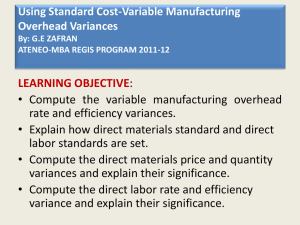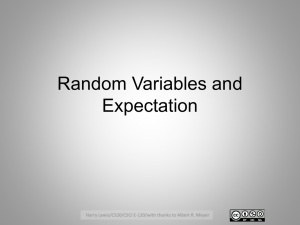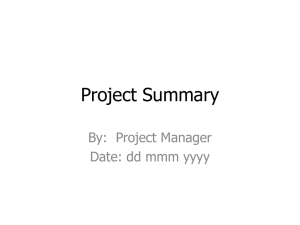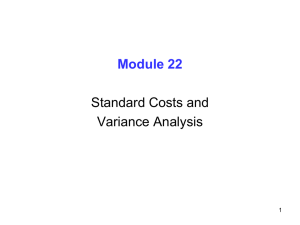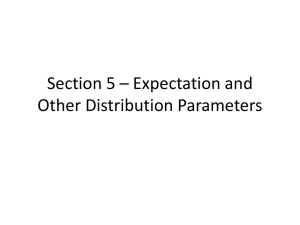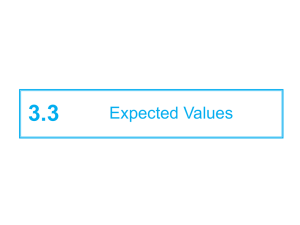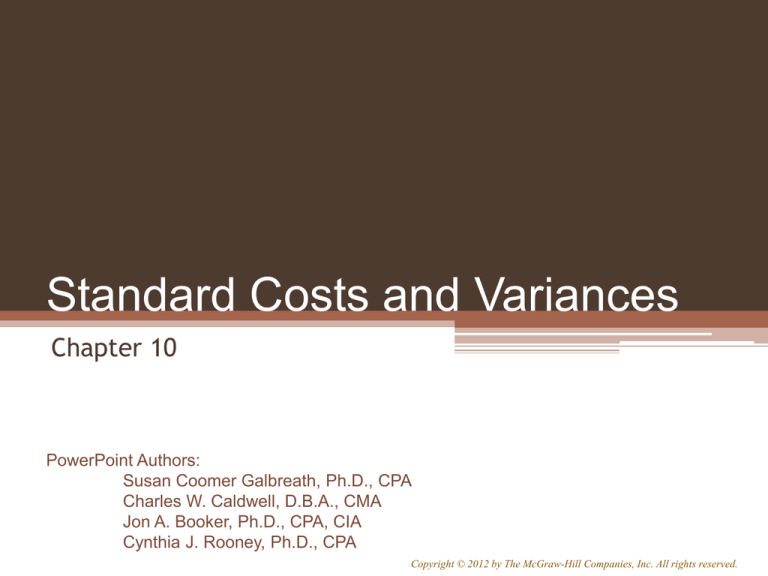
Standard Costs and Variances
Chapter 10
PowerPoint Authors:
Susan Coomer Galbreath, Ph.D., CPA
Charles W. Caldwell, D.B.A., CMA
Jon A. Booker, Ph.D., CPA, CIA
Cynthia J. Rooney, Ph.D., CPA
Copyright © 2012 by The McGraw-Hill Companies, Inc. All rights reserved.
10-2
Standard Costs
Standards are benchmarks or “norms” for
measuring performance. In managerial accounting,
two types of standards are commonly used.
Quantity standards
specify how much of an
input should be used to
make a product or
provide a service.
Price standards
specify how much
should be paid for
each unit of the
input.
Examples: Firestone, Sears, McDonald’s, hospitals,
construction, and manufacturing companies.
10-3
Standard Costs
Amount
Deviations from standards deemed significant
are brought to the attention of management, a
practice known as management by exception.
Standard
Direct
Labor
Direct
Material
Manufacturing
Overhead
Type of Product Cost
10-4
Variance Analysis Cycle
10-5
Setting Standard Costs
Should we use
ideal standards that
require employees to
work at 100 percent
peak efficiency?
Engineer
I recommend using practical
standards that are currently
attainable with reasonable
and efficient effort.
Managerial Accountant
10-6
Setting Direct Materials Standards
Standard Price
per Unit
Standard Quantity
per Unit
Final, delivered
cost of materials,
net of discounts.
Summarized in
a Bill of Materials.
10-7
Setting Direct Labor Standards
Standard Rate
per Hour
Standard Hours
per Unit
Often a single
rate is used that reflects
the mix of wages earned.
Use time and
motion studies for
each labor operation.
10-8
Setting Variable Manufacturing
Overhead Standards
Price
Standard
Quantity
Standard
The rate is the
variable portion of the
predetermined overhead
rate.
The quantity is
the activity in the
allocation base for
predetermined overhead.
10-9
The Standard Cost Card
A standard cost card for one unit of
product might look like this:
Inputs
Direct materials
Direct labor
Variable mfg. overhead
Total standard unit cost
A
B
AxB
Standard
Quantity
or Hours
Standard
Price
or Rate
Standard
Cost
per Unit
3.0 lbs.
2.5 hours
2.5 hours
$
$ 4.00 per lb.
14.00 per hour
3.00 per hour
$
12.00
35.00
7.50
54.50
10-10
Using Standards in Flexible Budgets
Standard costs per unit for direct materials, direct
labor, and variable manufacturing overhead can be
used to compute activity and spending variances.
Spending variances become more
useful by breaking them down into
quantity and price variances.
10-11
A General Model for Variance Analysis
Variance Analysis
Quantity Variance
Price Variance
Difference between
actual quantity and
standard quantity
Difference between
actual price and
standard price
10-12
Quantity and Price Standards
Quantity and price standards are
determined separately for two reasons:
The purchasing manager is responsible for raw
material purchase prices and the production manager
is responsible for the quantity of raw material used.
The buying and using activities occur at different times.
Raw material purchases may be held in inventory for a
period of time before being used in production.
10-13
A General Model for Variance Analysis
Variance Analysis
Quantity Variance
Price Variance
Materials quantity variance
Labor efficiency variance
VOH efficiency variance
Materials price variance
Labor rate variance
VOH rate variance
10-14
A General Model for Variance Analysis
(1)
Standard Quantity
Allowed for Actual Output,
at Standard Price
(SQ × SP)
(2)
Actual Quantity
of Input,
at Standard Price
(AQ × SP)
Quantity Variance
(2) – (1)
(3)
Actual Quantity
of Input,
at Actual Price
(AQ × AP)
Price Variance
(3) – (2)
Spending Variance
(3) – (1)
10-15
A General Model for Variance Analysis
Actual quantity is the amount of direct materials, direct
labor, and variable manufacturing overhead actually used.
(1)
Standard Quantity
Allowed for Actual Output,
at Standard Price
(SQ × SP)
(2)
Actual Quantity
of Input,
at Standard Price
(AQ × SP)
Quantity Variance
(2) – (1)
(3)
Actual Quantity
of Input,
at Actual Price
(AQ × AP)
Price Variance
(3) – (2)
Spending Variance
(3) – (1)
10-16
A General Model for Variance Analysis
Standard quantity is the standard quantity allowed
for the actual output of the period.
(1)
Standard Quantity
Allowed for Actual Output,
at Standard Price
(SQ × SP)
(2)
Actual Quantity
of Input,
at Standard Price
(AQ × SP)
Quantity Variance
(2) – (1)
(3)
Actual Quantity
of Input,
at Actual Price
(AQ × AP)
Price Variance
(3) – (2)
Spending Variance
(3) – (1)
10-17
A General Model for Variance Analysis
Actual price is the amount actually
paid for the input used.
(1)
Standard Quantity
Allowed for Actual Output,
at Standard Price
(SQ × SP)
(2)
Actual Quantity
of Input,
at Standard Price
(AQ × SP)
Quantity Variance
(2) – (1)
(3)
Actual Quantity
of Input,
at Actual Price
(AQ × AP)
Price Variance
(3) – (2)
Spending Variance
(3) – (1)
10-18
A General Model for Variance Analysis
Standard price is the amount that should
have been paid for the input used.
(1)
Standard Quantity
Allowed for Actual Output,
at Standard Price
(SQ × SP)
(2)
Actual Quantity
of Input,
at Standard Price
(AQ × SP)
Quantity Variance
(2) – (1)
(3)
Actual Quantity
of Input,
at Actual Price
(AQ × AP)
Price Variance
(3) – (2)
Spending Variance
(3) – (1)
10-19
Learning Objective 1
Compute the direct
materials quantity and
price variances and
explain their
significance.
10-20
Materials Variances – An Example
Glacier Peak Outfitters has the following direct
materials standard for the fiberfill in its mountain
parka.
0.1 kg. of fiberfill per parka at $5.00 per kg.
Last month 210 kgs. of fiberfill were purchased and
used to make 2,000 parkas. The materials cost a
total of $1,029.
10-21
Materials Variances Summary
Standard Quantity
×
Standard Price
200 kgs.
×
$5.00 per kg.
= $1,000
Actual Quantity
×
Standard Price
210 kgs.
×
$5.00 per kg.
= $1,050
Quantity variance
$50 unfavorable
Actual Quantity
×
Actual Price
210 kgs.
×
$4.90 per kg.
= $1,029
Price variance
$21 favorable
10-22
Materials Variances Summary
Standard Quantity
×
Standard Price
Actual Quantity
×
Standard Price
Actual Quantity
×
Actual Price
200 kgs.
210 kgs.
210 kgs.
0.1 kg per parka 2,000 parkas
×
×
×
= 200 kgs
$5.00 per kg.
$5.00 per kg.
$4.90 per kg.
= $1,000
= $1,050
Quantity variance
$50 unfavorable
= $1,029
Price variance
$21 favorable
10-23
Materials Variances Summary
Standard Quantity
×
Standard Price
200 kgs.
×
$5.00 per kg.
= $1,000
Actual Quantity
×
Standard Price
210 kgs.
× 210 kgs
$1,029
$5.00
per kg.
= $4.90
per kg
= $1,050
Quantity variance
$50 unfavorable
Actual Quantity
×
Actual Price
210 kgs.
×
$4.90 per kg.
= $1,029
Price variance
$21 favorable
10-24
Materials Variances:
Using the Factored Equations
Materials quantity variance
MQV = (AQ × SP) – (SQ × SP)
= SP(AQ – SQ)
= $5.00/kg (210 kgs – (0.1 kg/parka 2,000 parkas))
= $5.00/kg (210 kgs – 200 kgs)
= $5.00/kg (10 kgs) = $50 U
Materials price variance
MPV = (AQ × AP) – (AQ × SP)
= AQ(AP – SP)
= 210 kgs ($4.90/kg – $5.00/kg)
= 210 kgs (– $0.10/kg) = $21 F
10-25
Responsibility for Materials
Variances
Materials Quantity Variance
Production Manager
Materials Price Variance
Purchasing Manager
The standard price is used to compute the quantity variance
so that the production manager is not held responsible for
the purchasing manager’s performance.
10-26
Responsibility for Materials Variances
I am not responsible for
this unfavorable materials
quantity variance.
You purchased cheap
material, so my people
had to use more of it.
Production Manager
Your poor scheduling
sometimes requires me to
rush order materials at a
higher price, causing
unfavorable price variances.
Purchasing Manager
10-27
Quick Check
Zippy
Hanson Inc. has the following direct materials
standard to manufacture one Zippy:
1.5 pounds per Zippy at $4.00 per pound
Last week, 1,700 pounds of materials were
purchased and used to make 1,000 Zippies. The
materials cost a total of $6,630.
10-28
Quick Check
How many pounds of materials should
Hanson have used to make 1,000 Zippies?
a. 1,700 pounds.
b. 1,500 pounds.
c. 1,200 pounds.
d. 1,000 pounds.
Zippy
10-29
Quick Check
Zippy
How many pounds of materials should
Hanson have used to make 1,000 Zippies?
a. 1,700 pounds.
b. 1,500 pounds.
c. 1,200 pounds.
d. 1,000 pounds. The standard quantity is:
1,000 × 1.5 pounds per Zippy.
10-30
Quick Check
Zippy
Hanson’s materials quantity variance (MQV)
for the week was:
a. $170 unfavorable.
b. $170 favorable.
c. $800 unfavorable.
d. $800 favorable.
10-31
Quick Check
Zippy
Hanson’s materials quantity variance (MQV)
for the week was:
a. $170 unfavorable.
b. $170 favorable.
c. $800 unfavorable.
d. $800 favorable.
MQV = SP(AQ - SQ)
MQV = $4.00(1,700 lbs - 1,500 lbs)
MQV = $800 unfavorable
10-32
Quick Check
Hanson’s materials price variance (MPV)
for the week was:
a. $170 unfavorable.
b. $170 favorable.
c. $800 unfavorable.
d. $800 favorable.
Zippy
10-33
Quick Check
Zippy
Hanson’s materials price variance (MPV)
for the week was:
a. $170 unfavorable.
b. $170 favorable.
c. $800 unfavorable.
d. $800 favorable. MPV = AQ(AP - SP)
MPV = 1,700 lbs. × ($3.90 4.00)
MPV = $170 Favorable
10-34
Quick Check
Standard Quantity
×
Standard Price
Zippy
Actual Quantity
×
Standard Price
Actual Quantity
×
Actual Price
1,500 lbs.
×
$4.00 per lb.
1,700 lbs.
×
$4.00 per lb.
1,700 lbs.
×
$3.90 per lb.
= $6,000
= $ 6,800
= $6,630
Quantity variance
$800 unfavorable
Price variance
$170 favorable
10-35
Quick Check
Zippy
Recall that the standard quantity for 1,000 Zippies
is 1,000 × 1.5 pounds per Zippy = 1,500 pounds.
Standard Quantity
×
Standard Price
Actual Quantity
×
Standard Price
Actual Quantity
×
Actual Price
1,500 lbs.
×
$4.00 per lb.
1,700 lbs.
×
$4.00 per lb.
1,700 lbs.
×
$3.90 per lb.
= $6,000
= $ 6,800
= $6,630
Quantity variance
$800 unfavorable
Price variance
$170 favorable
10-36
Learning Objective 2
Compute the direct labor
efficiency and rate
variances and explain
their significance.
10-37
Labor Variances – An Example
Glacier Peak Outfitters has the following direct
labor standard for its mountain parka.
1.2 standard hours per parka at $10.00 per hour
Last month, employees actually worked 2,500
hours at a total labor cost of $26,250 to make
2,000 parkas.
10-38
Labor Variances Summary
Standard Hours
×
Standard Rate
Actual Hours
×
Standard Rate
Actual Hours
×
Actual Rate
2,400 hours
×
$10.00 per hour
2,500 hours
×
$10.00 per hour
2,500 hours
×
$10.50 per hour
= $24,000
= $25,000
= $26,250
Efficiency variance
$1,000 unfavorable
Rate variance
$1,250 unfavorable
10-39
Labor Variances Summary
Standard Hours
×
Standard Rate
2,400 hours
×
$10.00 per hour
= $24,000
Actual Hours
×
Standard Rate
Actual Hours
×
Actual Rate
2,500 hours
2,500 hours
1.2 hours per
× parka 2,000
×
parkasper
= 2,400
$10.00
hour hours$10.50 per hour
= $25,000
Efficiency variance
$1,000 unfavorable
= $26,250
Rate variance
$1,250 unfavorable
10-40
Labor Variances Summary
Standard Hours
×
Standard Rate
Actual Hours
×
Standard Rate
Actual Hours
×
Actual Rate
2,400 hours
2,500 hours
×
× hours
$26,250 2,500
$10.00 per hour = $10.50
$10.00per
perhour
hour
2,500 hours
×
$10.50 per hour
= $24,000
= $25,000
Efficiency variance
$1,000 unfavorable
= $26,250
Rate variance
$1,250 unfavorable
10-41
Labor Variances: Using the
Factored Equations
Labor efficiency variance
LEV = (AH × SR) – (SH × SR)
= SR (AH – SH)
= $10.00 per hour (2,500 hours – 2,400 hours)
= $10.00 per hour (100 hours)
= $1,000 unfavorable
Labor rate variance
LRV = (AH × AR) – (AH × SR)
= AH (AR – SR)
= 2,500 hours ($10.50 per hour – $10.00 per hour)
= 2,500 hours ($0.50 per hour)
= $1,250 unfavorable
10-42
Responsibility for Labor Variances
Production managers are
usually held accountable
for labor variances
because they can
influence the:
Mix of skill levels
assigned to work tasks.
Level of employee
motivation.
Quality of production
supervision.
Production Manager
Quality of training
provided to employees.
10-43
Responsibility for Labor Variances
I am not responsible for
the unfavorable labor
efficiency variance!
You purchased cheap
material, so it took more
time to process it.
I think it took more time
to process the
materials because the
Maintenance
Department has poorly
maintained your
equipment.
10-44
Quick Check
Hanson Inc. has the following direct labor
standard to manufacture one Zippy:
1.5 standard hours per Zippy at
$12.00 per direct labor hour
Last week, 1,550 direct labor hours were
worked at a total labor cost of $18,910
to make 1,000 Zippies.
Zippy
10-45
Quick Check
Hanson’s labor efficiency variance (LEV)
for the week was:
a. $590 unfavorable.
b. $590 favorable.
c. $600 unfavorable.
d. $600 favorable.
Zippy
10-46
Quick Check
Zippy
Hanson’s labor efficiency variance (LEV)
for the week was:
a. $590 unfavorable.
b. $590 favorable.
c. $600 unfavorable.
d. $600 favorable.
LEV = SR(AH - SH)
LEV = $12.00(1,550 hrs - 1,500 hrs)
LEV = $600 unfavorable
10-47
Quick Check
Hanson’s labor rate variance (LRV) for the
week was:
a. $310 unfavorable.
b. $310 favorable.
c. $300 unfavorable.
d. $300 favorable.
Zippy
10-48
Quick Check
Zippy
Hanson’s labor rate variance (LRV) for the
week was:
a. $310 unfavorable.
b. $310 favorable.
LRV = AH(AR - SR)
c. $300 unfavorable.
LRV = 1,550 hrs($12.20 - $12.00)
d. $300 favorable.LRV = $310 unfavorable
10-49
Quick Check
Zippy
Standard Hours
×
Standard Rate
Actual Hours
×
Standard Rate
Actual Hours
×
Actual Rate
1,500 hours
×
$12.00 per hour
1,550 hours
×
$12.00 per hour
1,550 hours
×
$12.20 per hour
= $18,000
= $18,600
Efficiency variance
$600 unfavorable
= $18,910
Rate variance
$310 unfavorable
10-50
Learning Objective 3
Compute the variable
manufacturing overhead
efficiency and rate
variances and explain
their significance.
10-51
Variable Manufacturing Overhead
Variances – An Example
Glacier Peak Outfitters has the following direct
variable manufacturing overhead labor standard
for its mountain parka.
1.2 standard hours per parka at $4.00 per hour
Last month, employees actually worked 2,500
hours to make 2,000 parkas. Actual variable
manufacturing overhead for the month was
$10,500.
10-52
Variable Manufacturing Overhead
Variances Summary
Standard Hours
×
Standard Rate
2,400 hours
×
$4.00 per hour
= $9,600
Actual Hours
×
Standard Rate
2,500 hours
×
$4.00 per hour
= $10,000
Efficiency variance
$400 unfavorable
Actual Hours
×
Actual Rate
2,500 hours
×
$4.20 per hour
= $10,500
Rate variance
$500 unfavorable
10-53
Variable Manufacturing Overhead
Variances Summary
Standard Hours
Actual Hours
Actual Hours
×
×
×
Standard Rate
Standard Rate
Actual Rate
2,400 hours
2,500 hours
2,500 hours
×
× parka 2,000
×
1.2 hours per
$4.00 per hour
$4.00 per
hour hours $4.20 per hour
parkas
= 2,400
= $9,600
= $10,000
Efficiency variance
$400 unfavorable
= $10,500
Rate variance
$500 unfavorable
10-54
Variable Manufacturing Overhead
Variances Summary
Standard Hours
Actual Hours
×
×
Standard Rate
Standard Rate
2,400 hours
2,500 hours
×
× hours
$10,500 2,500
$4.00 per hour
$4.00 per
per hour
hour
= $4.20
= $9,600
= $10,000
Efficiency variance
$400 unfavorable
Actual Hours
×
Actual Rate
2,500 hours
×
$4.20 per hour
= $10,500
Rate variance
$500 unfavorable
10-55
Variable Manufacturing Overhead
Variances: Using Factored Equations
Variable manufacturing overhead efficiency variance
VMEV = (AH × SR) – (SH – SR)
= SR (AH – SH)
= $4.00 per hour (2,500 hours – 2,400 hours)
= $4.00 per hour (100 hours)
= $400 unfavorable
Variable manufacturing overhead rate variance
VMRV = (AH × AR) – (AH – SR)
= AH (AR – SR)
= 2,500 hours ($4.20 per hour – $4.00 per hour)
= 2,500 hours ($0.20 per hour)
= $500 unfavorable
10-56
Quick Check
Zippy
Hanson Inc. has the following variable
manufacturing overhead standard to
manufacture one Zippy:
1.5 standard hours per Zippy at
$3.00 per direct labor hour
Last week, 1,550 hours were worked to make
1,000 Zippies, and $5,115 was spent for
variable manufacturing overhead.
10-57
Quick Check
Zippy
Hanson’s efficiency variance (VMEV) for
variable manufacturing overhead for the week
was:
a. $435 unfavorable.
b. $435 favorable.
c. $150 unfavorable.
d. $150 favorable.
10-58
Quick Check
Zippy
Hanson’s efficiency variance (VMEV) for
variable manufacturing overhead for the week
was:
a. $435 unfavorable.
b. $435 favorable.
1,000 units × 1.5 hrs per unit
c. $150 unfavorable.
d. $150 favorable.
VMEV = SR(AH - SH)
VMEV = $3.00(1,550 hrs - 1,500 hrs)
VMEV = $150 unfavorable
10-59
Quick Check
Hanson’s rate variance (VMRV) for variable
manufacturing overhead for the week was:
a. $465 unfavorable.
b. $400 favorable.
c. $335 unfavorable.
d. $300 favorable.
Zippy
10-60
Quick Check
Zippy
Hanson’s rate variance (VMRV) for variable
manufacturing overhead for the week was:
a. $465 unfavorable.
b. $400 favorable.
VMRV = AH(AR - SR)
c. $335 unfavorable.
VMRV = 1,550 hrs($3.30 - $3.00)
d. $300 favorable. VMRV = $465 unfavorable
10-61
Quick Check
Zippy
Standard Hours
×
Standard Rate
Actual Hours
×
Standard Rate
1,500 hours
×
$3.00 per hour
1,550 hours
×
$3.00 per hour
= $4,500
= $4,650
Efficiency variance
$150 unfavorable
Actual Hours
×
Actual Rate
1,550 hours
×
$3.30 per hour
= $5,115
Rate variance
$465 unfavorable
10-62
Materials Variances―An Important
Subtlety
The quantity variance
is computed only on
the quantity used.
The price variance is
computed on the entire
quantity purchased.
10-63
Materials Variances―An Important
Subtlety
Glacier Peak Outfitters has the following direct
materials standard for the fiberfill in its mountain
parka.
0.1 kg. of fiberfill per parka at $5.00 per kg.
Last month 210 kgs. of fiberfill were purchased at a
cost of $1,029. Glacier used 200 kgs. to make
2,000 parkas.
10-64
Materials Variances―An Important
Subtlety
Standard Quantity
×
Standard Price
200 kgs.
×
$5.00 per kg.
= $1,000
Actual Quantity
×
Standard Price
200 kgs.
×
$5.00 per kg.
= $1,000
Quantity variance
$0
10-65
Materials Variances―An Important
Subtlety
Actual Quantity
×
Standard Price
210 kgs.
×
$5.00 per kg.
= $1,050
Actual Quantity
×
Actual Price
210 kgs.
×
$4.90 per kg.
= $1,029
Price variance
$21 favorable
10-66
Variance Analysis and Management
by Exception
How do I know
which variances to
investigate?
Larger variances, in
dollar amount or as
a percentage of the
standard, are
investigated first.
10-67
A Statistical Control Chart
Warning signals for investigation
Favorable Limit
•
Desired Value
•
•
•
•
•
•
Unfavorable Limit
1
2
3
4
5
6
7
Variance Measurements
•
8
•
9
10-68
Advantages of Standard Costs
Management by
exception
Promotes economy
and efficiency
Advantages
Simplified
bookkeeping
Enhances
responsibility
accounting
10-69
Potential Problems with Standard Costs
Emphasizing standards
may exclude other
important objectives.
Standard cost
reports may
not be timely.
Invalid assumptions
about the relationship
between labor
cost and output.
Potential
Problems
Favorable
variances may
be misinterpreted.
Emphasis on
negative may
impact morale.
Continuous
improvement may
be more important
than meeting standards.
Predetermined Overhead Rates
and Overhead Analysis in a
Standard Costing System
Appendix 10A
PowerPoint Authors:
Susan Coomer Galbreath, Ph.D., CPA
Charles W. Caldwell, D.B.A., CMA
Jon A. Booker, Ph.D., CPA, CIA
Cynthia J. Rooney, Ph.D., CPA
Copyright © 2012 by The McGraw-Hill Companies, Inc. All rights reserved.
10-71
Learning Objective 4
(Appendix 10A)
Compute and interpret
the fixed overhead
volume and budget
variances.
10-72
Fixed Overhead Volume Variance
Fixed
Overhead
Applied
Budgeted
Fixed
Overhead
Actual
Fixed
Overhead
Volume
variance
Volume
variance
=
Budgeted
fixed
overhead
–
Fixed
overhead
applied to
work in process
10-73
Fixed Overhead Volume Variance
Fixed
Overhead
Applied
Budgeted
Fixed
Overhead
DH × FR
SH × FR
Actual
Fixed
Overhead
Volume
variance
Volume variance
=
FPOHR × (DH – SH)
FPOHR = Fixed portion of the predetermined overhead rate
DH = Denominator hours
SH = Standard hours allowed for actual output
10-74
Fixed Overhead Budget Variance
Fixed
Overhead
Applied
Budgeted
Fixed
Overhead
Actual
Fixed
Overhead
Budget
variance
Budget
variance
=
Actual
fixed
overhead
–
Budgeted
fixed
overhead
10-75
Computing Fixed Overhead Variances
ColaCo
Production and Machine-Hour Data
Budgeted production
Standard machine-hours per unit
Budgeted machine-hours
Actual production
Standard machine-hours allowed for the actual production
Actual machine-hours
30,000
3
90,000
28,000
84,000
88,000
units
hours
hours
units
hours
hours
10-76
Computing Fixed Overhead Variances
ColaCo
Cost Data
Budgeted variable manufacturing overhead
Budgeted fixed manufacturing overhead
Total budgeted manufacturing overhead
$
Actual variable manufacturing overhead
Actual fixed manufacturing overhead
Total actual manufacturing overhead
$
$
$
90,000
270,000
360,000
100,000
280,000
380,000
10-77
Predetermined Overhead Rates
Predetermined
Estimated total manufacturing overhead cost
=
overhead rate
Estimated total amount of the allocation base
Predetermined
$360,000
=
overhead rate
90,000 Machine-hours
Predetermined
= $4.00 per machine-hour
overhead rate
10-78
Predetermined Overhead Rates
Variable component of the
predetermined overhead rate
$90,000
=
90,000 Machine-hours
Variable component of the
predetermined overhead rate
= $1.00 per machine-hour
Fixed component of the
predetermined overhead rate
$270,000
=
90,000 Machine-hours
Fixed component of the
predetermined overhead rate
= $3.00 per machine-hour
10-79
Applying Manufacturing Overhead
Overhead
applied
=
Predetermined
overhead rate
Standard hours allowed
×
for the actual output
Overhead
applied
=
$4.00 per
machine-hour
× 84,000 machine-hours
Overhead
applied
=
$336,000
10-80
Computing the Volume Variance
Volume
variance
=
Budgeted
fixed
overhead
–
(
Fixed
overhead
applied to
work in process
)
$3.00 per
$84,000
×
machine-hour
machine-hours
Volume
variance
= $270,000 –
Volume
variance
= $18,000 Unfavorable
10-81
Computing the Volume Variance
Volume variance
=
FPOHR × (DH – SH)
FPOHR = Fixed portion of the predetermined overhead rate
DH = Denominator hours
SH = Standard hours allowed for actual output
(
)
Volume
variance
$3.00 per
90,000
84,000
=
–
×
machine-hour
mach-hours
mach-hours
Volume
variance
= 18,000 Unfavorable
10-82
Computing the Budget Variance
Actual
fixed
overhead
Budgeted
fixed
overhead
Budget
variance
=
Budget
variance
=
$280,000 – $270,000
Budget
variance
=
$10,000 Unfavorable
–
10-83
A Pictorial View of the Variances
Fixed Overhead
Applied to
Work in Process
252,000
Budgeted
Fixed
Overhead
270,000
Volume variance,
$18,000 unfavorable
Actual
Fixed
Overhead
280,000
Budget variance,
$10,000 unfavorable
Total variance, $28,000 unfavorable
10-84
Fixed Overhead Variances –
A Graphic Approach
Let’s look at a
graph showing
fixed overhead
variances. We will
use ColaCo’s
numbers from the
previous example.
10-85
Graphic Analysis of Fixed
Overhead Variances
Budget
$270,000
Denominator
hours
0
0
Machine-hours (000)
90
10-86
Graphic Analysis of Fixed
Overhead Variances
Actual
$280,000
Budget
$270,000
{
Budget Variance 10,000 U
Denominator
hours
0
0
Machine-hours (000)
90
10-87
Graphic Analysis of Fixed
Overhead Variances
Actual
$280,000
Budget
$270,000
Applied
$252,000
{
{
Budget Variance 10,000 U
Volume Variance 18,000 U
Standard
hours
Denominator
hours
0
0
Machine-hours (000)
84
90
10-88
Reconciling Overhead Variances and
Underapplied or Overapplied Overhead
In a standard
cost system:
Unfavorable
variances are equivalent
to underapplied overhead.
Favorable
variances are equivalent
to overapplied overhead.
The sum of the overhead variances
equals the under- or overapplied
overhead cost for the period.
10-89
Reconciling Overhead Variances and
Underapplied or Overapplied Overhead
ColaCo
Computation of Underapplied Overhead
Predetermined overhead rate (a)
Standard hours allowed for the actual output (b)
Manufacturing overhead applied (a) × (b)
Actual manufacturing overhead
Manufacturing overhead underapplied or
overapplied
$
$
$
$
4.00 per machine-hour
84,000 machine hours
336,000
380,000
44,000 underapplied
10-90
Computing the Variable Overhead
Variances
Variable manufacturing overhead efficiency variance
VMEV = (AH × SR) – (SH × SR)
= $88,000 – (84,000 hours × $1.00 per hour)
= $4,000 unfavorable
10-91
Computing the Variable Overhead
Variances
Variable manufacturing overhead rate variance
VMRV = (AH × AR) – (AH × SR)
= $100,000 – (88,000 hours × $1.00 per
hour)
= $12,000 unfavorable
10-92
Computing the Sum of All Variances
ColaCo
Computing the Sum of All variances
Variable overhead rate variance
Variable overhead efficiency variance
Fixed overhead budget variance
Fixed overhead volume variance
Total of the overhead variances
$
$
12,000
4,000
10,000
18,000
44,000
U
U
U
U
U
General Ledger
Journal
EntriesEntries
to Record
to
Variances
Record
Variances
Appendix 10B
PowerPoint Authors:
Susan Coomer Galbreath, Ph.D., CPA
Charles W. Caldwell, D.B.A., CMA
Jon A. Booker, Ph.D., CPA, CIA
Cynthia J. Rooney, Ph.D., CPA
Copyright © 2012 by The McGraw-Hill Companies, Inc. All rights reserved.
10-94
Learning Objective 5
(Appendix 10B)
Prepare journal entries
to record standard
costs and variances.
10-95
Glacier Peak Outfitters ― Revisited
We will use information from the Glacier Peak Outfitters
example presented earlier in the chapter to illustrate journal
entries for standard cost variances. Recall the following:
Material
AQ × AP = $1,029
AQ × SP = $1,050
SQ × SP = $1,000
MPV = $21 F
MQV = $50 U
Labor
AH × AR = $26,250
AH × SR = $25,000
SH × SR = $24,000
LRV = $1,250 U
LEV = $1,000 U
Now, let’s prepare the entries to record
the labor and material variances.
10-96
Recording Materials Variances
GENERAL JOURNAL
Date
Description
Raw Materials
Post.
Ref.
Page 4
Debit
Credit
1,050
Materials Price Variance
21
Accounts Payable
1,029
To record the purchase of material
Work in Process
Materials Quantity Variance
Raw Materials
To record the use of material
1,000
50
1,050
10-97
Recording Labor Variances
GENERAL JOURNAL
Date
Description
Work in Process
Post.
Ref.
Page 4
Debit
24,000
Labor Rate Variance
1,250
Labor Efficiency Variance
1,000
Wages Payable
To record direct labor
Credit
26,250
10-98
Cost Flows in a Standard Cost System
Inventories are recorded at standard cost.
Variances are recorded as follows:
Favorable variances are credits, representing
savings in production costs.
Unfavorable variances are debits, representing
excess production costs.
Standard cost variances are usually closed out
to cost of goods sold.
Unfavorable variances increase cost of goods sold.
Favorable variances decrease cost of goods sold.
10-99
End of Chapter 10

